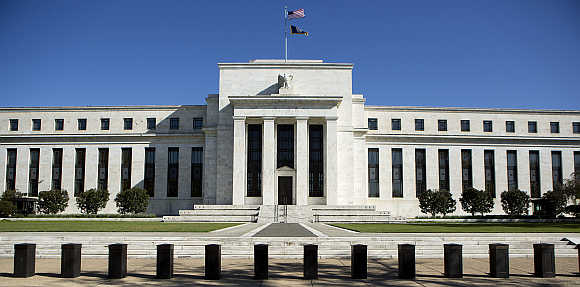
Market participants have been fine-tuning their investment strategy amid speculation the US Federal Reserve’s quantitative easing programme might well be entering the final lap. Data from China and Japan and the movement of key currencies have also impacted sentiment. Sanjay Mathur, Managing Director and Head of economics research for the Asia-Pacific (ex-Japan), The Royal Bank of Scotland, and Louis Kuijs, Chief China Economist, RBS, tell Puneet Wadhwa that with the US housing and labour markets on the mend, the healing looks more durable.
Edited excerpts:
What is your assessment on how things have shaped for the global economy over the past six months, and what’s the road ahead?
Louis: To start with, there are two important items of positive news from the developed world - uncertainty and risk emanating from the Euro zone crisis have come down and the US economy is starting to recover, with reasonably positive signals from the housing and labour markets. There are still quite a few caveats. There is no growth in the Euro zone and, with fiscal austerity, high unemployment and weak sentiment, even next year is going to look subdued. Our colleagues forecast 1.1 per cent growth next year, after a 0.4 per cent contraction this year.
...

Nonetheless, economically, the global growth outlook should get better in the developed world later this year and next year. That will be helpful in supporting growth in emerging markets and developing countries.
Are markets over-reacting to the developments, especially the readings on the US Fed’s quantitative easing plans?
Louis: I find it hard to say whether the markets are over-reacting or not because it seems the recent rise in prices of financial assets globally was in no small part based on monetary easing. I would say, though, from an economic perspective, an eventual fading out of QE in the US is on balance good news, since it means that the Fed has concluded that growth in the US, and the labour market performance, are strong enough to warrant a gradual return to normal monetary conditions. This should be good for the global economy and, eventually, also for equity markets.
What’s the sense you are getting from foreign investors on their allocation strategy in the Asian and emerging markets?
Sanjay: It’s difficult to club all emerging markets in one basket, as the set of issues and challenges confronting each of them are different. For India, investors are very concerned with external imbalances.
...

Even if there is a moderation in the current account deficit from the peak rate of 6.7 per cent of GDP (gross domestic product), investors will remain worried. Rising US yields have only added to the problem. In terms of foreign investor positioning in emerging markets, I would think that investors have yet to materially exit emerging markets. What we have seen is probably only a trailer.
How do you see Japan’s economy shaping?
Louis: Our colleagues working on Japan are reasonably constructive on its economic and financial outlook in the coming 6-12 months, as Abenomics seems to have revived confidence among businesses and consumers alike. The impact of the sizeable increase in liquidity in Japan on global financial markets could become significant, looking at the numbers, thus offsetting in part the possible impact of a tapering of QE3 in the US. Whether Japan is able to raise its economic growth rate on a sustained basis will depend on the third arrow of Abenomics, the structural reform component. In any case, given Japan's demographic prospects, I would expect its impact on global growth to diminish in the coming decade.
What about China?
Louis: We remain fairly constructive on China's economic outlook. With exports weak and domestic demand having slowed, growth is not going to be stellar this year but I think it will not fall below the bottom of the comfort range of the government of around seven per cent; we currently project 7.5 per cent for this year.
...

With capital controls still containing financial flows, the impact of China's economic and financial developments on the rest of the world will continue to be concentrated in the real economy sphere, in the coming 6-12 months. On the basis of our reasonably constructive growth prospects, we think China will remain the most important source of demand on most commodity markets.
What is your interpretation of the key economic data in the Indian context?
Sanjay: The growth-related data is unambiguously weak. Going forward, the growth momentum might improve, assuming some reforms do take place and the monsoon is normal, but even so, growth will remain below trend. The good news is that the May CPI (consumer price index) print notwithstanding, inflation is decisively turning lower. After a long time, inflation and growth are aligned with each other. This should allow the RBI to cut rates by another 50-75 basis points (bps) during the course of FY14.
Has India become less attractive now given the macros and the political landscape?
Sanjay: Investors are concerned with India's balance sheet. However, to be fair, they have become more relaxed on the fiscal situation. On other matters, such as creating an enabling policy framework for investment in infrastructure or accelerating FDI (foreign direct investment) flows in general, disappointment is widespread.
...

I also want to make an additional point - what investors want is real economy reforms - opening up the capital market to foreign investors does not augment the long-term productivity/growth of the economy and therefore, does not amount to real reform.
Is the worst behind us as regards the rupee?
Sanjay: I do think that while prospects for the rupee are far from great, there is a case to expect some stability. India's macro problems are well known and discounted in the financial market. Going forward, the current account should improve, albeit still not to a safe level. Still, an improvement is better than not at all. This should lend stability to the rupee. One caveat though. In times like these, attaining stability requires the central bank to stand up and lean against the wind i.e. the RBI (Reserve Bank of India) needs to send a strong signal. We have not seen that until now.
What has been your asset allocation strategy over the past one year and do you see this changing over the next 12 - 18 months?
Sanjay: Over the last year or so, we had been bullish on Asian bonds and currencies. Asian growth was stronger, interest rate differentials were high and volatility was low. The environment is radically different now and developed markets and the US in particular looks more attractive. The US economy is slowly but surely healing. Of course, over the last three years, there have been many false starts for the US economy, but with the housing and labour markets on the mend, the healing looks more durable. US stocks is really the way to go for now.